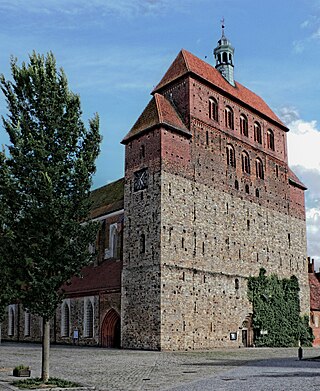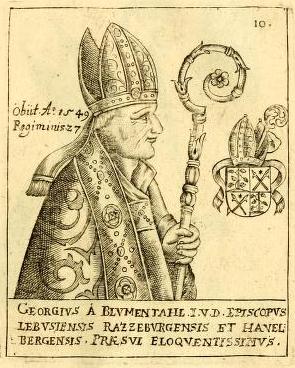

The diocese of Brandenburg existed between the 10th and 16th centuries. From the 12th century, its bishops also ruled the Hochstift Brandenburg.


The diocese of Brandenburg existed between the 10th and 16th centuries. From the 12th century, its bishops also ruled the Hochstift Brandenburg.
The foundation charter of the Brandenburg diocese is dated 1 October 948, though the actual founding date remained disputed among historians. The medieval chronicler Thietmar of Merseburg mentions the year 938; the bishopric may also have been established in the course of the partition of the vast Marca Geronis and the emergence of the Northern March after Margrave Gero's death in 965. With the foundation, King Otto (Holy Roman Emperor from 962) aimed at the Christianization of the Polabian Slavs (Wends) and the incorporation of their territory into the East Frankish realm.
Brandenburg was originally a suffragan of the Archbishopric of Mainz, but in 968 it came under the jurisdiction of the Magdeburg archbishops. The Great Slav Rising of 983 practically annihilated it, when revolting Lutici tribes conquered Brandenburg and the neighbouring Bishopric of Havelberg. Brandenburg bishops continued to be appointed, but they were merely titular, residing in Magdeburg or acting as auxiliary bishops in the western territories of the Empire. Not until the final subjugation of the Wends in the 12th century by Margrave Albert the Bear, the German eastward settlement (Ostsiedlung) in the diocesan region revived the bishopric.
Bishop Wigers of Brandenburg (acting 1138–60), an adherent of Norbert of Xanten, was the first of a series of bishops of the Premonstratensian Order, which chose the occupants of the episcopal see until 1447; in that year a bull of Pope Nicholas V gave the right of nomination to the Brandenburg elector, with whom the bishops stood in a close feudal relation. Bishop Wigers also established a Premonstratensian convent at Leitzkau (today part of Gommern, Saxony-Anhalt). Probably at the request of the Hevellian prince Pribislav-Henry, he established another convent at the Slavic Parduin settlement in present-day Brandenburg an der Havel, which became the nucleus of the revived Brandenburg cathedral chapter. The incorporation into the Premonstratensian Order was confirmed by Pope Clement III in 1188.

Albert the Bear was the first margrave of Brandenburg from 1157 to his death and was briefly duke of Saxony between 1138 and 1142.

The Prince-Bishopric of Brandenburg was an ecclesiastical principality of the Holy Roman Empire from the 12th century until it was secularized during the second half of the 16th century. It should not be confused with the larger Diocese of Brandenburg established by King Otto I of Germany in 948, in the territory of the Marca Geronis east of the Elbe river. The diocese, over which the prince-bishop exercised only spiritual authority, was a suffragan diocese of the Archdiocese of Magdeburg, its seat was Brandenburg an der Havel.

The Archbishopric of Magdeburg was a Latin Catholic archdiocese (969–1552) and Prince-Archbishopric (1180–1680) of the Holy Roman Empire centered on the city of Magdeburg on the Elbe River.
The Diocese of Ratzeburg is a former diocese of the Catholic Church. It was erected from the Diocese of Oldenburg c. 1050 and was suppressed in 1554. The diocese was originally a suffragan of the Archdiocese of Hamburg; in 1072 it became a suffragan of the merged entity — the "Archdiocese of Hamburg and the Diocese of Bremen". The territory of the diocese was located in what is today the states of Schleswig-Holstein and Mecklenburg-Vorpommern in Germany. The cathedral church of the diocese — dedicated to Ss. Mary and John — is still extant in the city of Ratzeburg. Following its suppression as part of the Protestant Reformation, the remaining Catholic adherents were only represented by the Apostolic Vicariate of Northern Germany. The whole territory of the diocese is today included in the Roman Catholic Archdiocese of Hamburg.

The Diocese of Lebus is a former diocese of the Catholic Church. It was erected in 1125 and suppressed in 1598. The Bishop of Lebus was also, ex officio, the ruler of a lordship that was coextensive with the territory of the diocese. The geographic remit included areas that are today part of the land of Brandenburg in Germany and the Province of Lubusz in Poland. It included areas on both sides of the Oder River around the town of Lebus. The cathedral was built on the castle hill in Lubusz and was dedicated to St Adalbert of Prague. Later, the seat moved to Górzyca, back to Lebus and finally to Fürstenwalde on the River Spree.

The Bishopric of Havelberg was a Roman Catholic diocese founded by King Otto I of Germany in 946, from 968 a suffragan to the Archbishops of Magedeburg. A Prince-bishopric (Hochstift) from 1151, Havelberg as a result of the Protestant Reformation was secularised and finally annexed by the margraves of Brandenburg in 1598.

Georg von Blumenthal was a German Prince-Bishop of Ratzeburg and Bishop of Lebus. He also served as a Privy Councillor of the Margraviate of Brandenburg and Chancellor of the University of Frankfurt (Oder), commonly called the Viadrina.

In the Holy Roman Empire, the German term Hochstift referred to the territory ruled by a bishop as a prince, as opposed to his diocese, generally much larger and over which he exercised only spiritual authority. The terms prince-bishopric and ecclesiastical principality are synonymous with Hochstift. Erzstift and Kurerzstift referred respectively to the territory (prince-archbishopric) ruled by a prince-archbishop and an elector-archbishop while Stift referred to the territory ruled by an imperial abbot or abbess, or a princely abbot or abbess. Stift was also often used to refer to any type of ecclesiastical principality.

In the Slavic revolt of 983, Polabian Slavs, Wends, Lutici and Obotrite tribes, that lived east of the Elbe River in modern north-east Germany overthrew an assumed Ottonian rule over the Slavic lands and rejected Christianization under Emperor Otto I.
The Prince-Bishopric of Naumburg-Zeitz was a medieval diocese in the central German area between Leipzig in the east and Erfurt in the west. The seat of the bishop was Zeitz Cathedral in Zeitz from 968 and 1029 and Naumburg Cathedral in Naumburg between 1029 and 1615. It was dissolved in the wake of the Reformation. The Bishopric of Zeitz-Naumburg encompassed the four archdeaconries of Naumburg, Zeitz, Altenburg and "trans Muldam".

The House of Alvensleben is an ancient, Low German (niederdeutsch) noble family from the Altmark region, whose earliest known member, Wichard de Alvensleve, is first mentioned in 1163 as a ministerialis of the Bishopric of Halberstadt. The family name derives from Alvensleben Castle. They are one of the oldest extant German aristocratic families.
The 13 Cuirassier regiments of Old Prussia were formed in the mid-17th to mid-18th centuries, and formed the basis of Frederick the Great's vaunted cavalry.
Dietrich von Hardenberg was bishop of the Diocese of Brandenburg from 1521 to 1526.

Dietrich von Bülow was a German Bishop of Lebus-Fürstenwalde.